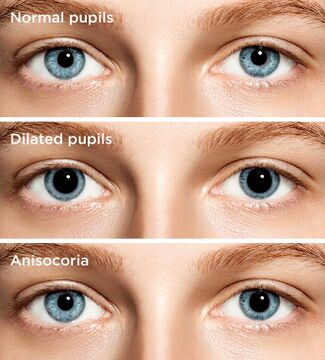When assessing a patient's pupils, first look to see if there are any easily seen signs that will potentially cause abnormalities in your assessment such as cataracts. A patient's pupils are evaluated using the PERRL mnemonic:
Pupils are Equal, Round, and Reactive to Light.
Equality[edit | edit source]

Pupils should, barring normal anisocoria (see image) found in 10% of the population, be the same size. Pupillary size is measured in millimeters, oftentimes from 2 mm to 9 mm with pinpoint and fully dilated found at either end. Normal pupillary size varies with environmental lighting conditions with smaller pupils in brighter scenarios and larger pupils in darker conditions. Abnormally sized pupils for the lighting conditions can be indicators of potential pharmacological intervention or other pathophysiological issues.
Pupillary response should also be bilaterally equal, meaning if one pupil reacts to light, so should the other.
Roundness[edit | edit source]
Normal pupils are round. If you find that a patient's pupil is not round, they may be the product of surgery or trauma and may not react normally to light. Ask your patient about any eye surgery or trauma.
Reactivity[edit | edit source]
Pupils should react fairly quickly to light. A sluggish pupillary response can indicate increased intracranial pressure or damage to the brain as well as damage to the eye itself. A fully unreactive pupil may be a severe finding in patients but may also be due to a prosthetic.
To check reactivity, shine a penlight from lateral to medial and look for constriction of the pupil as the light passes over it. The other pupil should follow suit. In the absence of a penlight, asking the patient to close their eyes for several seconds then open them will produce similar results in a bright room or sunlight.
Pupils may also be tested for accommodation (the constriction of a pupil as it focuses on a nearby object, then dilation as it continues to stay fixed on that nearby object), but this test is rarely placed in a patient care report or utilized in the field.
